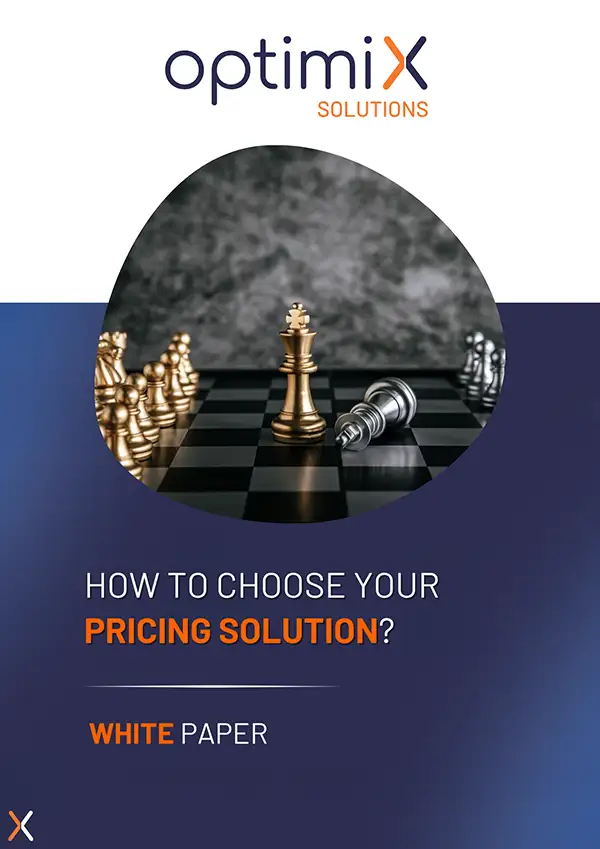Today, a company no longer has the luxury of improvising its pricing policy. Consumers compare offers in a matter of seconds, and every penny can sway a purchasing decision. The pressure on prices has become unbearable. Margins are shrinking, competitors are multiplying, and the slightest price difference can be costly.
Price is now a strong signal to the market, a profitability tool and a positioning lever. That’s what’s at stake with the pricing strategy.
In this context, the strategy of price alignment can be seen as a pragmatic and controlled response: set prices as close as possible to those on the market to avoid a destructive price war, remain competitive and preserve margins. Far from being a simple mimicry, it’s an assertive strategic choice, which enables you to consolidate your market share while avoiding provoking your competitors.
In this content section, we’ll be taking a closer look at this price alignment strategy: how it fits into an overall pricing policy, its advantages and pitfalls, and above all, how to implement it effectively without sacrificing margins.
Pricing policy: What is a price alignment strategy?
Aligning your prices doesn’t mean blindly copying those of your neighbor. It’s a structured, strategic approach, based on active market intelligence and rigorous observation of the competition. The objective? To adjust our own prices appropriately, balancing competitiveness and profitability.
In concrete terms, the price alignment strategy consists of setting prices in line with those charged by competitors.
It can take several forms:
Strict alignment: we systematically match competitor prices.
Conditional alignment: on specific references, distribution channels or periods.
Dynamic alignment: automated via predefined pricing rules, often driven by technology tools or pricing intelligence solutions.
Properly implemented, this strategy relies on a detailed understanding of the competitive environment and the ability to react quickly to market developments. It is also a form of pricing strategy, enabling a company to consolidate its position without entering into a logic of systematic sell-off.
But price alignment is more than just a business decision: it’s a cross-functional lever. It must be part of an overall strategic policy that integrates the company’s vision, internal resources (human, technological, financial), operational processes and culture. This coherence enhances performance and offers a real competitive advantage, particularly in highly competitive or poorly differentiated sectors.
Why adopt a price alignment policy?
Implementing a price alignment strategy enables the company to remain competitive while ensuring consistency in its positioning. It helps establish a clear framework for sales and marketing teams, reinforces credibility with customers and facilitates collaboration with distributors. This strategy reduces the risk of pricing errors and misperceived innovations, by building on market references.
It is particularly useful for growing companies or those with complex organizations, as it simplifies training, management and performance monitoring. By structuring its pricing policy in this way, the company becomes more agile and better prepared to adapt to market changes. Find out why this alignment strategy can help you achieve your business objectives. Article available here
What are the benefits of an alignment strategy for your company?
One of the first benefits of price alignment is the ability to secure competitiveness. By staying in line with the market, the company reduces the risk of price discrepancies perceived by consumers, particularly in sectors where price comparisons are instantaneous (e-commerce, food retailing, etc.).
Another advantage is margin control. Unlike aggressive reductions or massive promotions, alignment aims to preserve margins while remaining attractive. It also helps reduce the sales and marketing pressure associated with price differentials deemed unjustified by customers.
The price alignment policy also helps reduce the risks associated with untested innovation, particularly in companies operating in mature or highly standardized sectors. By relying on market standards, the company minimizes risky experimentation while ensuring overall consistency.
Last but not least, it’s a lever for customer loyalty. Customers feel they are paying a fair price, in line with the market, which limits frustration and encourages repeat purchases.
How to implement a price alignment strategy?
Implementing a price alignment strategy requires a rigorous, multi-stage approach.
It all starts with an in-depth strategic analysis: this involves assessing your market positioning, understanding the dynamics of the competition, and clarifying the objectives to be achieved (gaining market share, protecting your margins, repositioning your offering…).
This phase must be completed by an organizational diagnosis: what are current practices? Where are the gaps with your ambitions? This will help you identify the adjustments you need to make.
The next step is to draw up a concrete action plan that goes beyond price. It must also take into account customers’ perception of value, associated services, commercial communication and promotional policy. To guarantee success, it is essential to involve all the teams concerned (marketing, sales, finance, etc.) and to establish a clear, comprehensible and coherent framework.
Finally, the strategy must be based on rigorous data-driven management: definition of relevantindicators, gap analysis, corrective action. Because price alignment is not a fixed position, but a dynamic process that evolves according to the market, the competition and customer feedback.
The role of Machine Learning in price alignment policy
The integration of Machine Learning is revolutionizing the management of pricing strategies, particularly in the context of an alignment policy. While human teams can quickly become overwhelmed by the mass and complexity of the data to be analyzed, Machine Learning algorithms offer unrivalled analytical and predictive power.
One of the key functionalities of these algorithms is the automated collection of competitive data via online scraping, notably the competitive pricing. This process enables real-time retrieval of competitors’ prices, promotions and offers on various digital channels, providing a rich, constantly updated database.
To take full advantage of this data and automate decision-making, solutions like XPA – Optimix Pricing Analytics offer an advanced platform for intelligent pricing. Our pricing tool combines automatic data collection, detailed analysis of competitive data and pricing scenario simulations based on Machine Learning. It enablesprices to be adjusted in real time, while controlling the impact on margins and ensuring coherent alignment with overall sales strategy.
Thanks to these technologies, it becomes possible to model complex scenarios, anticipate market reactions to price variations, and precisely identify the segments or channels where price is most sensitive. In this way, Machine Learning refines price alignment beyond a simple mechanical comparison, detecting opportunities for strategic adjustments that maximize profitability.
What’s more, these systems learn continuously, improving their recommendations as data accumulates. The result is faster, more reliable decision-making, and a pricing policy that is both aligned with the market and optimized for financial performance.
What are the 3 types of pricing strategies?
Setting a price is more than just calculating costs or reacting to the competition. It’s a strategic decision that reflects your positioning, influences your customers’ perception of value, and largely determines your bottom line. There are different pricing strategies including three major approaches:
1. Skimming strategy: enhancing innovation and exclusivity
This strategy consists of offering a high price right from the launch of a product or service, in order to appeal primarily to the most motivated consumers, who are often less price-sensitive. It maximizes initial profitability, while reinforcing a premium image. It is particularly suitable for innovative, differentiating or high-profile offers.
2. The penetration strategy: rapidly conquering a market
Here, the objective is clear: to gain volume. The company enters the market with attractive prices to stimulate rapid adoption of its offering. This approach favors rapid expansion in the face of competition, but requires excellent cost control and rigorous margin management. It can also create a barrier to entry for new competitors.
3. The alignment strategy: staying competitive without losing coherence
Price alignment is based on close observation of the market and competitive practices. The company chooses to adjust to reference prices so as not to appear out of step. This strategy is appropriate when the aim is to maintain consistent positioning while meeting market expectations. It requires a good diagnosis of gaps, a clear reading of performance indicators and the ability to adjust if necessary.
The different price alignment policies
Pricing alignment policies can take a variety of forms, adapted to companies’ objectives and constraints. Whether it’s direct alignment with the competition, a tiered strategy or dynamic adjustment via algorithms, each approach offers its own advantages and challenges. To understand these types of strategies in detail and choose the one that best suits your business, read our full article.
what are the disadvantages of a price alignment policy?
Alignment of prices without any real strategy can lead to commoditization of the offer and a deflationary spiral. When too many players seek to align themselves without any real differentiation, the market can quickly descend into a destructive price war, where the only competitive variable becomes the price.
One of the major dangers lies in the loss of differentiation. Blindly following market prices, without taking into account one’s own value proposition, is tantamount to obliterating oneself in the eyes of customers. The company then becomes interchangeable, weakening its brand and diluting what made it unique.
In large organizations, implementing an alignment strategy can also come up against internal obstacles: complex structures, diverse distribution channels, heterogeneous contacts and resistance to change. These organizational challenges call for solid support, combining leadership, pedagogy and adapted tools.
Poorly calibrated alignment can also be detrimental to profitability. The most common mistake is to align with a competitor with very different volumes or cost structures. This pricing mimicry, without taking into account the economic realities specific to each company, inevitably leads to an erosion of margins.
Finally, it’s crucial to remember that alignment must never overshadow differentiation. Even in extremely competitive markets, maintaining a strong, distinct value proposition remains an essential competitive lever.
Example of a price alignment strategy
When a brand launches into a new market segment, adopting a pricing alignment strategy can become a powerful competitive lever. Well-orchestrated, it enables the brand to adapt to market expectations while remaining profitable.
In the food retail sector, many chains are adopting dynamic price alignment. They continuously monitor competitors’ prices on FMCG products, and use automation tools to adjust their prices according to geographic zone, sales channel (store, drive-through, e-commerce) or even time of day. The aim: to reassure consumers while stimulating sales in a fluid omnichannel logic.
In the non-food sector, some chains are seeking to reinforce price consistency across all channels (website, store, mobile app), while personalizing offers thanks to customer data. Finally, in sensitive sectors such as healthcare, the alignment strategy is applied to certain product segments, combined with differentiating services and quality support.
In an ever-changing business environment, price alignment can no longer be seen as a one-off operation. It has become an essential strategic lever for competitiveness, customer perception and profitability.
In a context of inflation, channel fragmentation and diversification of purchasing paths, alignment must be dynamic, data-driven and integrated into business processes. Maintaining consistency, personalizing offers and adapting in real time are no longer options, but imperatives.
The most successful retailers are no longer subject to the market: they anticipate it. They continuously test, model and adjust. This is the logic behind XPA – Optimix Pricing Analytics, our solution designed to structure, automate and make reliable pricing decisions in real time.
The future of pricing belongs to organizations capable of combining agility, technology and strategic vision. Those who turn pricing alignment into a sustainable competitive advantage will emerge stronger in the race for performance.








